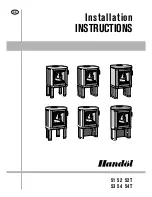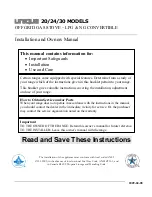
8
fluence draft, in some cases it may be disad-
vantageous wind direction, combined with the
position of the chimney can cause negative draft
(it blows through the chimney), causing smoke
escape from the stove.
Before using after a long period of inactivity,
check that the chimney is free for any blocka-
ges. (soot build-up, bird nests, leaves etc.).
reduced draft can occur when:
• The temperature difference is too small
between smoke gasses and outdoor
temperature, for eg. poorly insulated chimney
• To short of a chimney
• The outside temperature is high, and indoor
temperature is low for eg. in summer
• False air in the chimney
• Chimney is blocked
• Air tight house (lack of combustion air supply)
• Poorly placed chimney for the surroundings,
for ex. the ridge and trees may cause
turbulence
Good draft occurs when:
• Th
e difference in temperature in the chimney
(warmer) and outside temperature (colder)
• It is clear weather
• The chimney has the right height min 4 meters
above the stove, and clear of the roof ridge.
1.10 fuel
Your new stove is EN approved for firing with
wood fuel. You must therefore only burn clean,
dry wood in your stove. Never use your stove
to burn driftwood, as this may contain a lot of
salt which can damage both the stove and the
chimney. Similarly, you must not fire your stove
with refuse, painted wood, pressure-impregna
ted wood or chipboard, as these materials can
emit poisonous fumes and smoke.
Correct firing using well seasoned wood pro-
vides optimal heat output and maximum effi-
ciency. At the same time, correct firing prevents
environmental damage in the form of smoke
emissions and reduces the risk of chimney fires.
If the wood is damp and inadequately seasoned,
a large proportion of the energy in the fuel will be
used to vaporize the water and this will all disap-
pear up the chimney. Thus, it is important to use
dry, well seasoned wood, for eg. wood with a
moisture content of less than 20 %. Achieve this
by storing the wood for 1–2 years before use.
Pieces of firewood with a diameter of more than
10 cm should be split before before storing. The
pieces of firewood should be of an appropriate
length (approx. 22-30 cm) so that they can lie
flat on the bed of embers.
If you store your wood outdoors, it is best to
cover it.
examples of fuel values
for different woods and their typical densities
per cubic meter, specified for 100% wood with
a moisture content of 18%.
Wood
kg/m
3
Wood
kg/m
3
Beech
710
Willow
560
Oak
700
Alder
540
Ash
700
Scotch pine
520
Elm
690
Larch
520
Maple
660
Lime
510
Birch
620
Spruce
450
Mountain pine
600
Poplar
450
It is advised not to use oil-containing woods
like teak tree and mahogany, as this can cau-
se damage to the glass.
heating value in wood
You have to use about 2.4 kg normal wood to
replace one litre of heating oil. All woods have
almost the same heating value per kg, which is
about 5.27 kW/hour for absolute dry wood.
Wood with a moistness of 18% has a efficiency
of about 4.18 kW / hour per kg, and one litre
heating oil contains about 10 kW / hour.
Co
2
release
At combustion 1000 litres of heating oil forms 3.171
tons CO
2
. As wood is a CO
2
neutral heat/energy
source, you save the environment about 1.3 kg CO
2
every time you have used 1 kg normal wood.
1.11 operational problems
The chimney must be swept at least once a
year, we recommend the use of a NACS (natio-
nal association of chimney sweeps) registered
chimney sweep.
In the event of smoke or malodorous fumes are
being produced, you must first check to see
whether the chimney is blocked.
The chimney must, of course, always provide the
minimum draft necessary to ensure that it is pos-
sible to regulate the fire. Please note, how-ever,
that chimney draft is dependent on the weather
Содержание Scan-Line Tour 10
Страница 2: ...2...
Страница 20: ...20 3 1 adjusting the stoves feet 1 2 3 4 See page 13 5...
Страница 24: ...24...









































